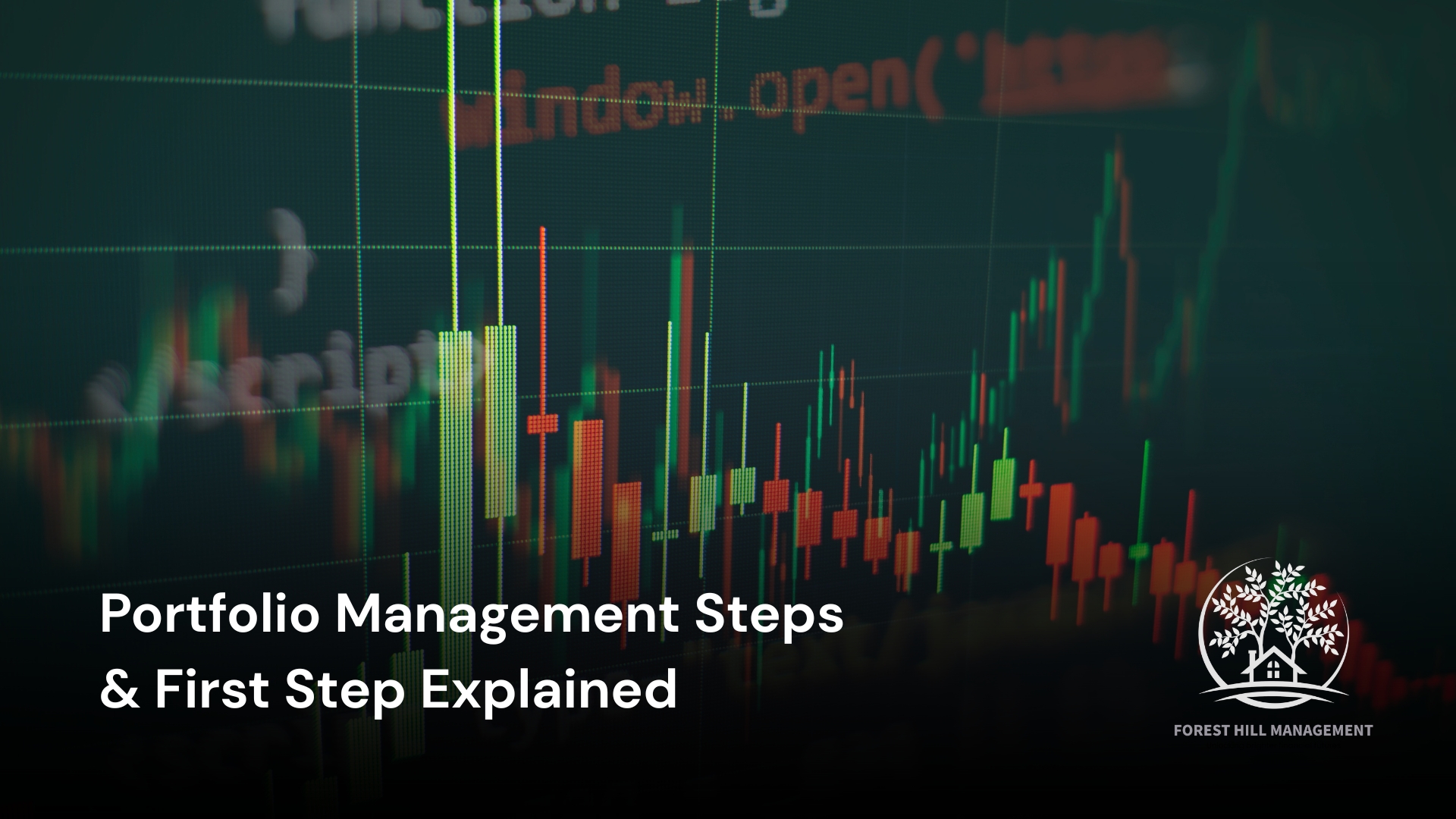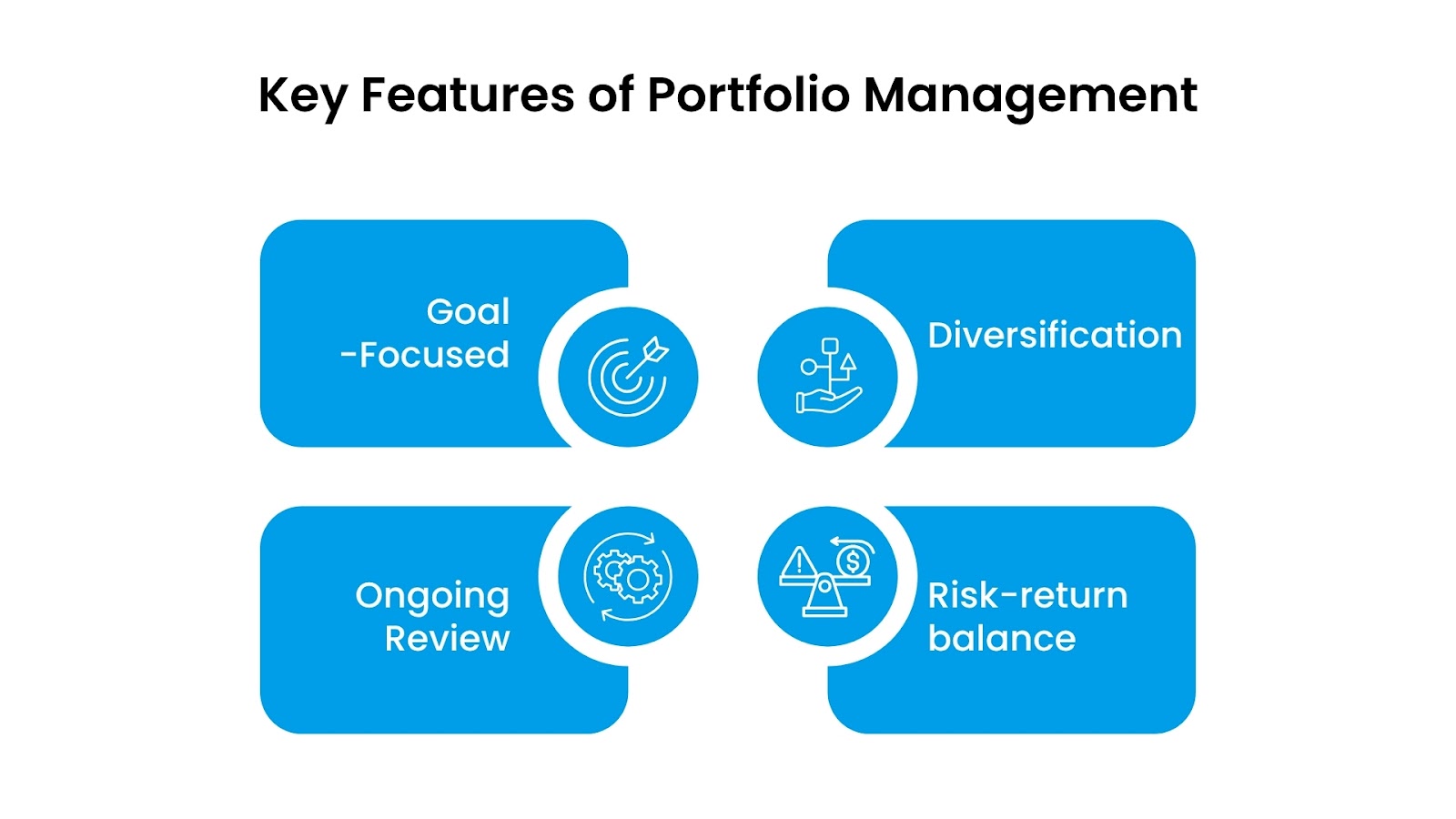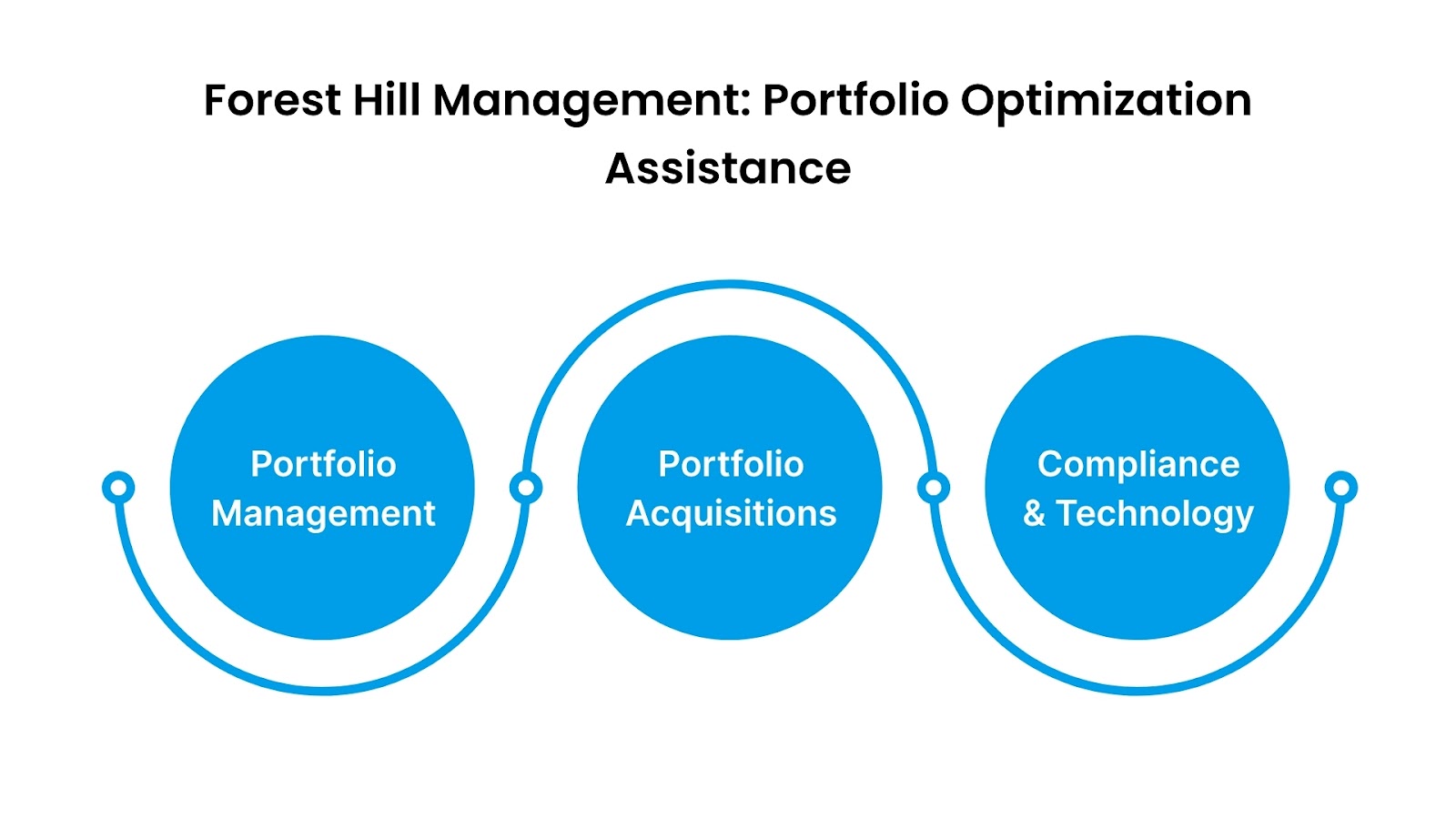Portfolio Management Steps and First Step Explained
Portfolio Management Steps and First Step Explained

Transform Your Financial Future
Contact UsAre you feeling lost with all the options in investing, the ups and downs of returns, and changing money goals? You are not alone. Financial market shifts bring challenges and opportunities, making even experienced investors rethink how to grow wealth and protect their hard-earned assets.
The hardest part isn't just about choosing between stocks, bonds, or other investments. It's about knowing where to start, figuring out how to organize your finances, and ensuring every choice brings you closer to what you truly want.
If managing your investments feels confusing, let's understand the basics of portfolio management. Along with the key steps involved, gaining clarity, confidence, and practical skills to keep your investments on track.
Key Takeaways
- The first step in portfolio analysis is to assess your current financial situation, review assets, liabilities, cash flow, and investments to build a strong foundation.
- Effective portfolio management is built on clear goals, smart diversification, and regular portfolio checkups, ensuring your investments keep working for you over time.
- Major trends like AI-driven insights, continuous real-time planning, and integrated tools are reshaping how organizations manage portfolios, making the process more agile and data-driven.
- Partnering with an experienced provider like The Forest Hill Management can simplify complex tasks such as portfolio strategy, acquisitions, and compliance, giving you expert guidance every step of the way.
What is Portfolio Management?
Portfolio management is the process of choosing and overseeing a mix of investments, like stocks, bonds, and cash, to reach your unique financial goals. Instead of putting your money in just one place, portfolio management helps you spread out your investments and control risk while aiming for steady growth.
The main purpose of portfolio management is to make your money work for you in the smartest way possible, all while matching your own needs, plans, and comfort with risk.
Key Features of Portfolio Management

- Goal-Focused: Every choice in your portfolio is based on your personal financial goals, like saving for college, retirement, or buying a home.
- Diversification: Portfolio management spreads investments across different asset types to lower the risk of losing money if one investment doesn’t do well.
- Ongoing Review: It’s not a one-time thing; you review and adjust your portfolio regularly as your goals or the market change.
- Risk and Return Balance: Decisions are made to balance how much risk you can handle with the return you hope to get.
With the basics in mind, let's examine "what is management's first step when performing a portfolio analysis?" and understand your current financial standing, followed by other steps.
What are Management's Steps When Performing a Portfolio Analysis?
When you begin analyzing your portfolio, the first and most important step is to look closely at your current financial situation. What is management's first step when performing a portfolio analysis? The answer is to get real about your finances by reviewing your assets, liabilities, cash flow, and current investments.
This foundation provides a clear and accurate picture of your current standing, helping to guide every subsequent investment decision.
Step 1: Get Real About Your Finances
Start by taking a detailed inventory of all your financial elements:
- Assets: List everything you own of value, such as cash, savings, property, vehicles, and investment accounts.
- Liabilities: Add up all debts and obligations, like loans, credit cards, or mortgages.
- Cash Flow: Track your income and regular expenses to see how much money you truly have to invest.
- Investments: Check all your current investment holdings and review their performance.
Step 2: Set Down Your Investment Goals
Once you know where you stand, it's time to set clear, realistic goals for your portfolio:
- Time Horizon: Decide how long you plan to invest. Are you saving for something short-term, or is this a long-term goal, such as retirement?
- Risk-Return Profile: Think about how much risk you're comfortable with and the kind of returns you hope to achieve.
- Benchmarking: Choose reference points, such as stock market indexes, to measure your progress and judge your portfolio's success.
Step 3: Decide What Assets You'll Invest In
Now, figure out your ideal asset mix. Diversification is critical; spreading investments across different types of holdings lowers risk and improves balance. Here's an example:

Relative Risk Cheat Sheet
- Stocks: Highest growth potential, higher risk.
- Bonds: Reliable payouts, moderate risk.
- Alternatives: (like real estate or commodities): Extra diversification.
- Cash: Safety, but lowest returns.
Step 4: Select Specific Investments
After you’ve chosen your asset mix, select the real-life investments that fill each category.
- Actively Managing Your Portfolio: Make regular buy/sell decisions and adjust your portfolio in response to market changes.
- Passively Managing Your Portfolio: Choose index funds or ETFs to keep your portfolio in line with the market, requiring fewer changes and less frequent attention.
Step 5: Monitor, Measure, Rebalance
Markets and personal goals change. That's why you need to:
- Regularly check how your portfolio is doing compared to your benchmarks.
- Rebalance your holdings if one asset type grows too much and disrupts your targeted asset mix.
- Adjust your investments if your situation, needs, or goals shift.
Consistent monitoring and adjustment keep your investment plan strong and on track, helping you reach your financial goals with greater confidence.
Now that you know the steps, it's helpful to understand what you gain from following this approach. Portfolio management lets you prioritize projects, use resources wisely, reduce risks, and improve returns.
The Benefits of Portfolio Management

Portfolio management is more than just handling investments; it's a strategic approach that helps you make smarter decisions, optimize resources, and reach your financial goals with greater confidence.
Here are the key benefits, each illustrated with practical examples to bring the concepts to life.
1. Prioritize Projects and Investments Effectively
Portfolio management helps you focus on the projects or investments that align best with your goals, ensuring that attention and resources are directed to what matters most.
Example:
A company considering multiple projects uses portfolio management to rate each by expected return and strategic fit. It chooses to prioritize launching a new product over upgrading equipment because the product promises higher long-term growth.
2. Optimize Resource Utilization
By carefully evaluating projects and investments, portfolio management ensures your time, money, and personnel are used where they can yield the highest impact.
Example:
An investor automates monthly portfolio reviews to detect underperforming assets early. This allows reallocating funds to better-performing investments, maximizing the value of each dollar invested.
3. Manage and Reduce Risk Through Diversification
Spreading investments across various asset classes and sectors lowers the chance that a single loss will significantly hurt your overall portfolio. This strategy leads to more stable growth.
Example:
Instead of holding only technology stocks, an investor diversifies into healthcare, bonds, and international assets. If technology underperforms, other sectors help cushion losses and maintain portfolio balance.
4. Improve Return on Investment (ROI)
Focused portfolio management supports steady returns by matching investments to your risk tolerance and objectives, combined with regular monitoring and rebalancing.
Example:
When one investor notices their stock holdings have grown from 60% to 80%, they sell some stocks and buy bonds to lock in gains and reduce risk, maintaining their original balance and investment strategy.
5. Achieve Better Business and Project Outcomes
Consistency and clear criteria in portfolio decisions make your projects and investments more aligned with strategic goals, improving overall success and reducing reactive, emotion-driven choices.
Example:
If a startup tracks multiple projects through portfolio management and notices a product launch that exceeds its budget with low returns, it should consider adjusting its budget accordingly. The team shifts resources to a more promising service, avoiding further losses and strengthening overall results.
By focusing on these benefits, portfolio management helps you to prioritize wisely, deploy resources efficiently, reduce risks, and boost returns, setting a solid path toward your financial and business objectives.
The field of portfolio management is evolving fast. Staying informed on trends like AI-driven insights, continuous planning, and integrated tools will keep your strategies current and effective
Emerging Trends Shaping the Future of Strategic Portfolio Management (SPM)
Making the right decisions with limited time and resources is challenging, especially when priorities shift rapidly and the pressure to deliver results is high. If you face difficulties in aligning projects, gaining clear visibility across teams, or proving the value of initiatives. Understanding these emerging SPM trends can help you work smarter and stay ahead.
List of emerging trends shaping the future of strategic portfolio management:
1. AI-Augmented Decision Making
Artificial intelligence is increasingly embedded in SPM tools, offering fast analysis of large data sets, trend detection, and predictive insights. This enhances decision speed and accuracy, helping you manage risks and seize opportunities more confidently.
2. Continuous Planning and Real-Time Adaptation
Static annual plans are replaced by ongoing, flexible planning. This approach lets you adjust priorities and resource allocation immediately in response to changing business conditions, keeping your portfolio aligned with your goals at all times.
3. Outcome-Focused and OKR-Driven Portfolios
SPM is shifting towards managing portfolios based on measurable objectives and key results (OKRs). This ensures every project contributes directly to defined business outcomes, helping you focus efforts on what truly drives value.
4. Integrated Planning Across the Enterprise
Connecting financial, operational, and strategic plans breaks down silos. Integrated planning improves transparency and collaboration, so that every initiative supports the overall business strategy and resources are used efficiently.
5. Increased Adoption and Tooling Advancements
New SPM platforms offer real-time dashboards, automated workflows, and AI-driven recommendations. These tools simplify portfolio management, making advanced capabilities accessible even for smaller teams, and improving execution and oversight.
These trends collectively enhance agility, data-driven decision-making, and strategic focus in portfolio management, making it a clear and proactive approach to organizational success.
If managing these steps feels complex, The Forest Hill Management offers expert support. Their tailored services help simplify portfolio management, from strategy to acquisition to compliance.
How The Forest Hill Management Helps You with Portfolio Management

Portfolio management can be challenging, whether you are an individual investor or a business managing multiple financial assets. The Forest Hill Management brings over 20 years of expertise to guide you confidently through these challenges, offering tailored services that simplify portfolio management and help you achieve your financial goals.
- Expert Portfolio Management: They provide customized strategies, efficient tracking, and regular reporting to keep your investments aligned with your goals while handling daily management so you can focus elsewhere.
- Portfolio Acquisitions: Their thorough due diligence and seamless process help you acquire portfolios that match your objectives, supporting growth and minimizing risks during transitions.
- Compliance and Technology: With strict regulatory adherence and advanced security measures, they ensure your financial data is protected while using technology to enhance efficiency.
Their expert, personalized approach supports your entire financial journey, managing current assets, acquiring new opportunities, and maintaining compliance, giving you the confidence to grow and protect your wealth.
Take the first step toward smarter portfolio management. Contact the Forest Hill Management team today to create your personalized financial plan.
Conclusion
Effective portfolio management is crucial for achieving your financial objectives. It provides order and clarity, even when things are changing fast around you.
To manage your portfolio well, you need to start with the basics. First, understand your current financial situation. Next, set clear and simple goals.
Then, diversify your investments by spreading your money across different assets. Finally, regularly check how your portfolio is performing. Doing these things makes your investments work in your favor. Technological progressions and ideas are enhancing portfolio management. AI-powered insights, continuous planning that adapts in real time, and easy-to-use tools help both individuals and businesses make smarter decisions. These changes enable you to react quickly, focus on results, and be better prepared for whatever comes next.
The Forest Hill Management is ready to guide you through every step. With their experience, they assist you in finding the right investments and ensure everything complies with industry rules. They combine trusted strategies with the latest technology to make portfolio management easier for you.
FAQs
1. What do portfolio managers do?
Portfolio managers create and oversee investment strategies tailored to client goals and risk levels. They decide when and what to buy or sell, monitor portfolios, and adjust them to meet financial objectives while managing risk.
2. What is the difference between a financial advisor and a portfolio manager?
A financial advisor provides broad financial planning advice, while a portfolio manager focuses specifically on managing investments. Portfolio managers actively design and adjust portfolios to meet investment goals, starting with understanding the client’s current finances.
3. Why would we need active portfolio management today?
Active portfolio management helps respond quickly to market changes, seize opportunities, and manage risks. It offers personalized strategies aiming to outperform the market and include tax-efficient tactics.
4. Best way to learn about practical portfolio management?
Learn through online courses, practical books, and finance communities. Hands-on practice with real or simulated portfolios and seeking mentorship deepens understanding of portfolio steps, including management's first step in portfolio analysis.
-p-500%20(1).png)